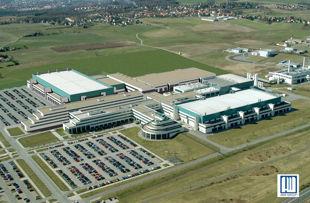
Advanced Micro Devices Inc. (AMD) started as a producer of logic chips in 1969, then entered the RAM chip business in 1975. That same year, it introduced a reverse-engineered clone of the Intel 8080 microprocessor. During this period, AMD also designed and produced a series of bit-slice processor elements (Am2900, Am29116, Am293xx) which were used in various minicomputer designs.
During this time, AMD attempted to embrace the perceived shift towards RISC with their own AMD 29K processor, and they attempted to diversify into graphics and audio devices as well as flash memory. While the AMD 29K survived as an embedded processor and AMD continues to make industry leading flash memory, AMD was not as successful with its other endeavors. AMD decided to switch gears and concentrate solely on Intel-compatible microprocessors and flash memory. This put them in direct competition with Intel for x86 compatible processors and their flash memory secondary markets.
1976 : AMD and Intel sign their first comprehensive cross-license agreement, where AMD and Intel both agree to license to each other all patents each company holds.
1982 : IBM selects an Intel microprocessor for its PC but only on the condition that there is a reliable second source supplier for its PC processor needs. As a result, AMD renews a comprehensive cross-license agreement with Intel and becomes IBM’s second-source manufacturer of the 8086 and 8088 microprocessors.
1987 : Intel notifies AMD it is terminating the second source agreement, an aggressive move to prevent AMD from producing a 486-compatible microprocessor. This begins years of legal disputes between AMD and Intel, and limits customer choice to a single source for PC microprocessors for the next several years.
1990 : In late 1990, AMD releases the Am386 ® microprocessor family, based on Intel’s 80386. Sales of the Am386 are strong due to its exceptional performance.
1991 : In October 1991, Intel commenced a federal court action for copyright infringement. An arbitrator subsequently awarded AMD full rights to make and sell the Am386. The Supreme Court of California upheld this decision in 1994.
1993 : The Am486 ® microprocessor is introduced; it powers Compaq computers and thousands of other manufacturers’ PCs.
1995 : AMD introduces the AMD-K5 ® microprocessor, its first independently designed, socket-compatible x86 microprocessor.
1997 : AMD introduces the successful AMD-K6 ® microprocessor, a pin-compatible alternative to Intel’s Pentium™ microprocessor . Its introduction heralds the return of competition and helps drive PC costs down below $1,000 to create PCs that are affordable for the average consumer.
1998 : AMD substantially advances the PC platform with the launch of the AMD-K6-2 microprocessor, featuring 3DNow!™ technology. Invented by AMD, 3DNow! technology was the first x86 innovation to significantly enhance 3D graphics, multimedia, and other floating-point-intensive applications for Microsoft ® Windows ®-compatible PCs.
1999 : AMD makes a clean break from creating Intel-compatible chips with the introduction of the world’s fastest x86 microprocessor, the AMD Athlon™. AMD Athlon processors were designed specifically from the ground up to run Microsoft Windows exceptionally well. AMD previews the world’s first 64-bit x86 multi-core architecture at the Microprocessor Forum.
2000 : AMD is first to break the historic 1GHz (one billion clock cycles per second) barrier with the AMD Athlon processor. AMD introduced PowerNow!™ technology, which allowed PC manufacturers to deliver cooler, quieter running notebook systems with extended system battery life. AMD announces the world’s first PC platform supporting Double Data Rate (DDR) memory technology; while Intel adopts the costly Rambus DRAM (RDRAM), which eventually failed.
2001 : AMD drives the development and widespread adoption of its HyperTransport™ technology, which allows computers to run faster and more efficiently. HyperTransport adopters include Sun Microsystems, Agilent, Apple Computer, Broadcom, Cisco Systems, IBM, nVidia and Texas Instruments. Introduces QuantiSpeed™ architecture in its Athlon XP lineup.
2002 : AMD’s Athlon XP family debuts Cool‘n’Quiet™technology, an on-chip power management solution for compact desktop PCs. Cool’n’Quiet effectively lowers the power consumption and enables a quieter-running system while delivering performance on demand to help maximize the computing experience.
2003 : The launch of the AMD Opteron™ and AMD Athlon™ 64 microprocessors changes the future of the computer industry by extending x86 to 64 bits with the AMD64 architecture – featuring simultaneous 32- and 64-bit computing. introduces the industry’s first processor with an integrated memory controller. AMD delivers Direct Connect Architecture, which directly connects processors, memory controllers and input/output (I/O) functions, reducing bottlenecks and increasing performance.
2004 : AMD Athlon 64 processor named Microprocessor Report’s “Desktop PC Chip of the Year.” Demonstrates the first x86 dual-core microprocessor. At the World Economic Forum Annual Meeting, AMD launches its 50x15 initiative; a commitment to deliver basic computing and Internet connectivity to 50 percent of the world’s population by the year 2015. Later this year in India, AMD launches the Personal Internet Communicator (PIC), a new category of computing device created specifically for developing markets.
2005 : AMD launches Dual-Core AMD Opteron processors for servers and workstations, and also unveils the AMD Athlon 64 X2 Dual-Core processor for consumer and business users. AMD continues its commitment to the 50x15 Initiative at the World Economic Forum Annual Meeting, announcing a partnership with MIT Media Lab chairman Nicholas Negroponte and other industry leaders to develop the world’s first $100 laptop. AMD also debuts working prototype of 2 nd generation PIC device.
Source : amd.com, wikipedia
 I still remember the Far Cry 64bit version demo video, which boasted of advanced physics simulation and rendering due to the power of AMD64 architecture. That was really marvelous. And now I really can't wait to see it done by a fully dedicated hardware. Till now 20 games have been announced for PhysX PPU. To name a few-
I still remember the Far Cry 64bit version demo video, which boasted of advanced physics simulation and rendering due to the power of AMD64 architecture. That was really marvelous. And now I really can't wait to see it done by a fully dedicated hardware. Till now 20 games have been announced for PhysX PPU. To name a few-




















